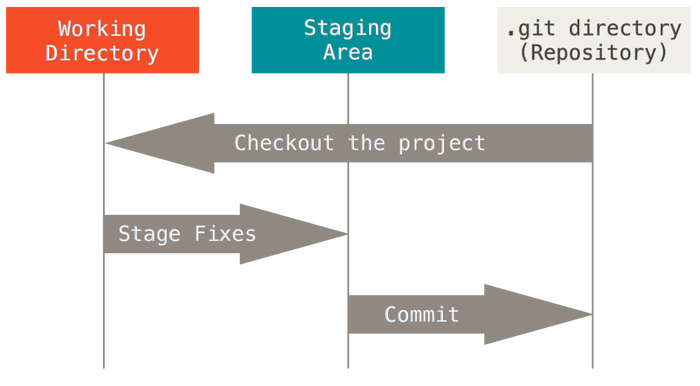有用的git建议
本文参考 Git – Useful Tips 一文翻译,不当之处,敬请谅解

这篇文章的目的是给经常使用git管理项目提供一个有益的提醒。如果你是git新手,可以先阅读文后的引用部分,然后在回头阅读此篇文章。在介绍git命令之前,你可以先看看来自 on-my-zsh 提供的别名。
基本命令
-
git config --global user.name "Your Name" -
git config --global user.email "youremail@example.com" -
git config --global core.editor <your favorite editor here>- Ex:
git config --global core.editor vim
- Ex:
-
git init:初始化一个repo。
Commit 结构
-
git status(gst):查看 repo 状态 - 工作区:
- .git 目录
- 暂存区
- 工作目录

-
git add <filename>(ga):添加一个文件到暂存区 -
git add .(gaa):添加所有文件到暂存区 -
git add *.js:添加所有后缀为js的文件到暂存区 -
git rm --cached <file>:从暂存区删除一个新文件 -
git commit -m "My first commit"(gcmsg):创建一次带 message 的提交 -
git commit -v -a(gca):-
-v是 verbose 的缩写,会在底部显示差异信息和更多有意义的信息 -
-a类似于git add .,会添加所有被修改和删除的文件,但会忽略新创建的文件
-
-
git help <command>:查看对应命令的帮助手册 -
git log(glg,glgg,glo,glog):查看项目的提交历史
暂存区管理
-
git reset HEAD <filename>(grh):从暂存区删除一个被修改的文件 -
git reset HEAD(grh):从暂存区删除所有被修改的文件 -
git checkout <filename>(gco):从暂存区删除一个被修改的文件,并撤销文件的更改 -
git commit -m "My first commit" --amend:添加文件/更改在暂存区的最后一次提交 -
git commit -v -a --amend(gca!):添加文件/更改在暂存区的最后一次提交 -
.gitignore:告诉git,哪些文件不被加入版本跟踪- 可以使用
git add <filename> -f命令添加一个不被版本跟踪的文件
- 可以使用
-
git diff <filename>(gd):查看基于当前文件的最后一次提交的更改差异 -
git diff(gd):查看基于所有文件的最后一次提交的更改差异 -
git reset HEAD~2 --soft:从项目提交历史中删除最近两次提交,但不丢弃文件的更改 -
git reset HEAD~2 --hard:从项目提交历史中删除最近两次提交,但会丢弃文件的更改和在(最后两次)提交中创建的新文件 -
git reset <commit> --soft --hard:-
--soft:将所有被更改的文件回溯到“待提交”状态 -
--hard:commit之后,对被git追踪的文件的任何更改都被丢弃
-
-
git reflog:显示包括被撤销
在内的所有提交 -
git merge <commit hash>:重新提交(restore the commit) -
git clean -f:删除工作目录中不被git进行版本追踪的文件
Stashed & Branches
Stash
-
git stash(gsta):将所有暂存区的文件移动到“储藏区”,类似于另一种类型的工作区 -
git stash list:查看储藏队列(Stash lists) -
git stash apply:将最近一次储藏恢复到暂存区(可以用类似git stash apply stash@{num}(num从0开始计数) 的命令来使用在队列中的任意一个储藏(stashes)) -
git stash clear:清空储藏队列 -
git stash save "name of the stash":为储藏设置命名 -
git stash pop(gstp):将最近一次储藏恢复到暂存区并从储藏队列删除此储藏 -
git stash drop(gstd):从储藏队列删除最近一次储藏(stash@{0})(git stash drop stash@{num}从储藏队列删除指定储藏)
Branch
-
git checkout -b dev(gco):创建 dev 分支并从当前分支切换到 dev 分支 -
git branch(gb):查看所有分支 -
git checkout master(gcm):切换到主分支 -
git merge <branch>(gm):合并分支 -
git rebase master:先将 master 上的更改合并到当前分支,再添加当前分支的更改。如果有冲突,解决冲突后加--continue参数继续合并 -
git branch -d <branch>: 删除分支,-D则强制删除分支 -
git merge <branch> --squash:将多次提交合并成一个,其流程如下:
# Go to the `master` branch git checkout master # Create a temp branch git checkout -b temp # Merge the feature/x branch into the temp using --squash git merge feature/x --squash # See the new modifications/files in the Staging Area git status # Create the unified commit git commit -m "Add feature/x" # Delete the feature/x branch git branch -D feature/x - rebase 和 merge 的区别:
- rebase:
- 提交历史(的展示)是线性的
- 缺点:会删除最近一个 commit,然后创建一次新的 commit
- 如果已提交到远程,不要使用 rebase
- merge:
- 提交历史(的展示)是分叉的
- 对于两个分支的合并,会创建一个次新的 commit
- rebase:
远程仓库管理
-
git remote add <name> <url>:添加一个将被追踪的远程仓库 -
git remote rm <name>:移除一个远程仓库 -
git push <remote> <remote-branch>(gp,ggp):将当前分支的本地 commit 推送到远程仓库 -
git fetch <remote> <remote-branch>:拉取远程仓库的最新 commit 到当前(本地)分支(<remote>/<branch>),不会合并 -
git pull <remote> <remote-branch>(gl,ggl):拉取远程仓库的最新 commit 到当前(本地)分支,并自动 merge-
git pull --rebase(gup):以 rebase 的方式进行合并,而不是 merge
-
其它有用的命令
-
git tag <name>:创建一个 tag(如:v1.3) -
git push --tags:将本地 tags 推送到远程仓库 -
git push <tag>:推送指定的本地 tag 到远程
引用
正文到此结束
热门推荐
相关文章
Loading...











![[HBLOG]公众号](http://www.liuhaihua.cn/img/qrcode_gzh.jpg)

